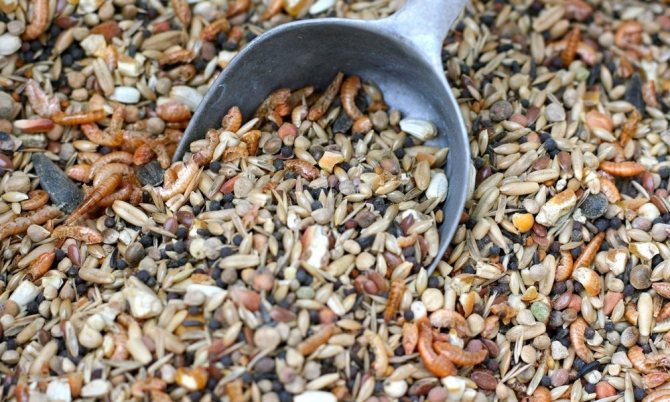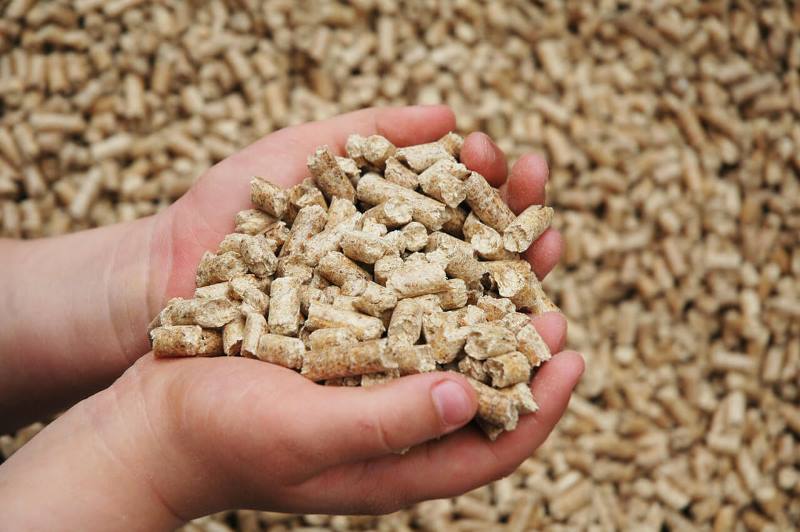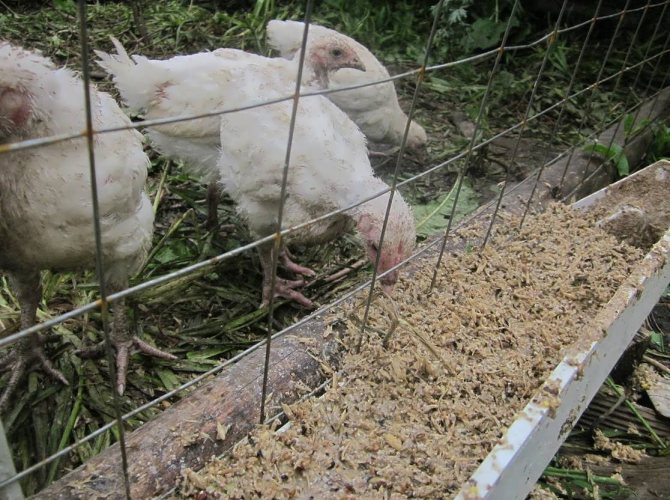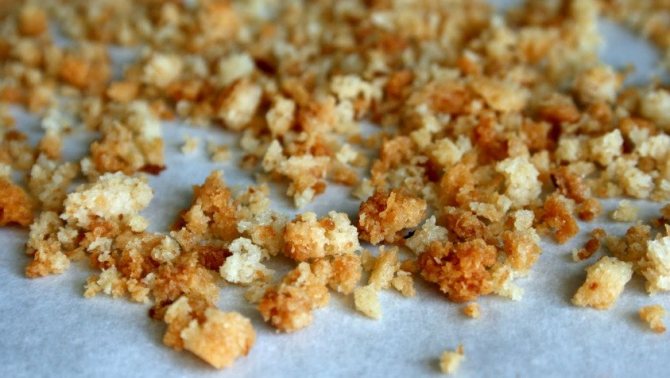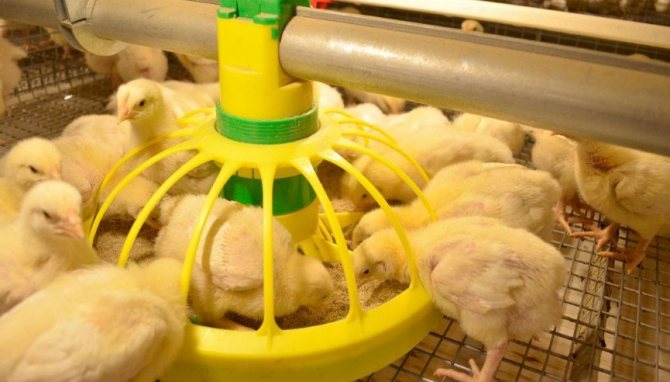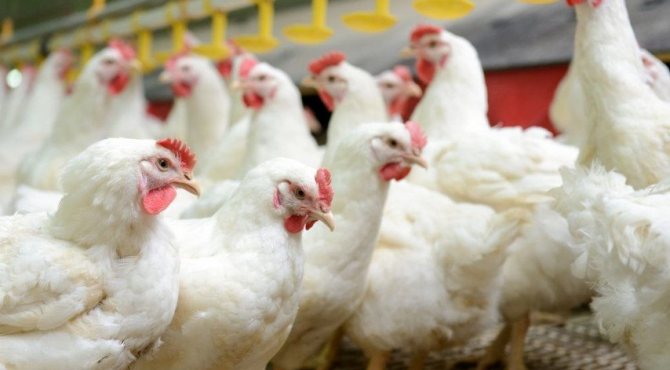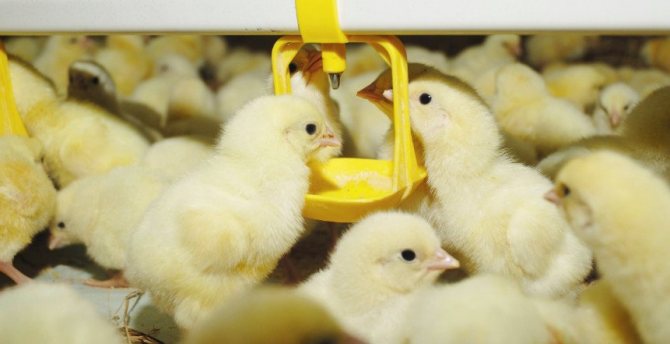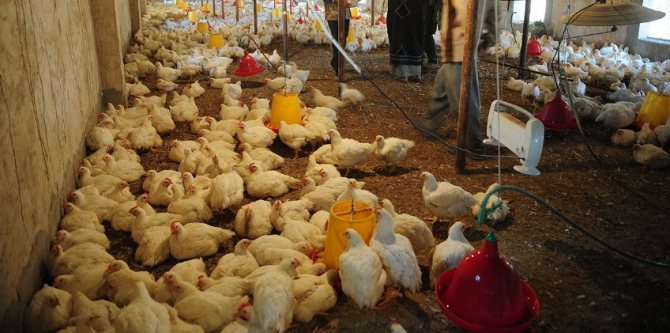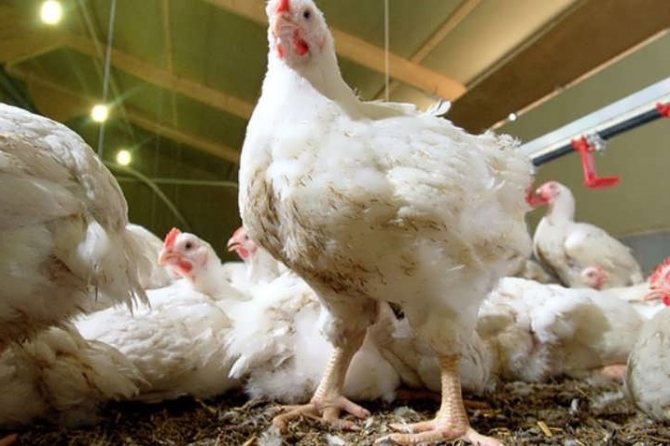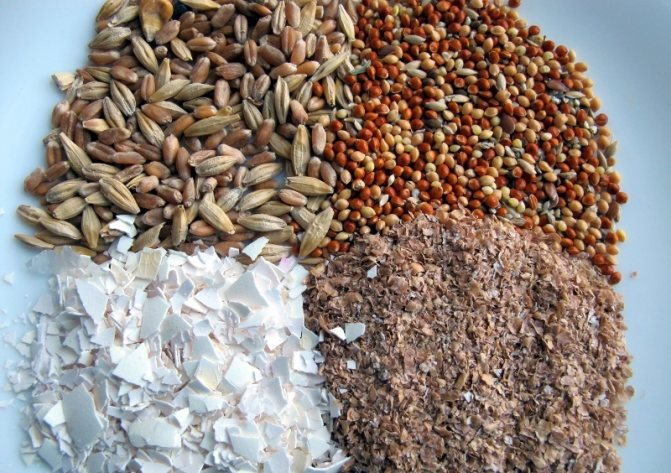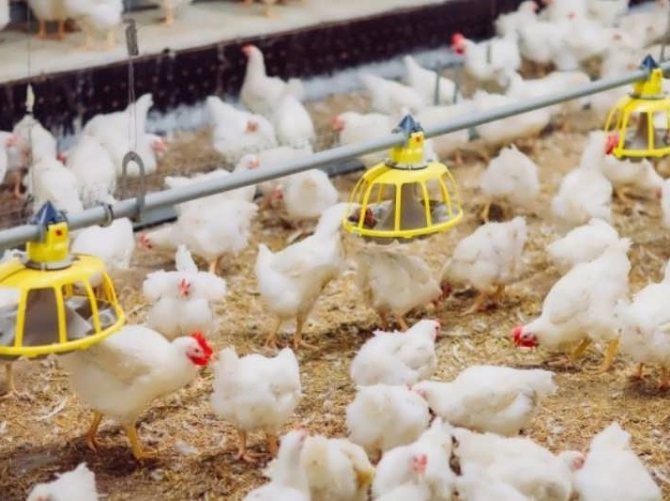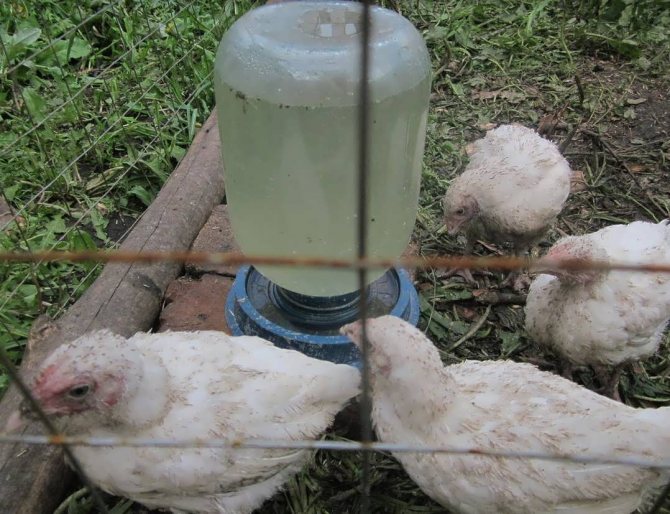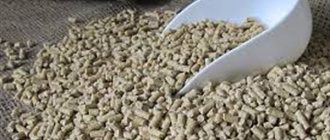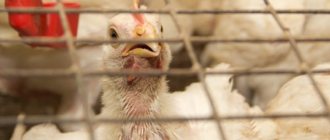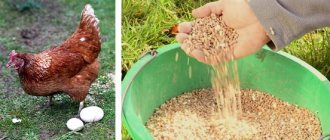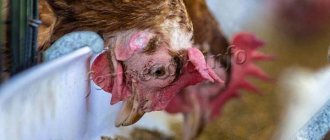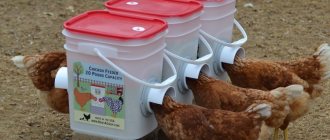Chickens - broilers have long been the constant companions of any successful poultry breeder and farmer. Growing these pets does not take much time, and the result is worthy of all praise. Broilers gain weight much faster and more actively compared to other breeds, and are also distinguished by unpretentious care, resistance to typical diseases and conditions of detention. However, really good results cannot be achieved if you do not adhere to the basic rules for growing, among which special attention is paid to nutrition and composition of feed. Our article provides all the necessary information on the composition of feed for broilers, as well as options for making such mixtures at home.
Compound feed and dry feed for poultry
Broiler feed is prepared in advance. The composition of feed for broilers includes not only nutrients, but also useful substances. Compound feed for broiler chickens contains a lot of fiber and calcium, the necessary additives provide a rapid increase in muscle mass.
Making food with your own hands is not difficult, the main condition for high-quality animal food is compliance with proportions and high-quality ingredients. Compound feed is prepared from winter or autumn for the whole year in advance.
The broiler breed is prized for its tasty meat, which the feathered breed grows throughout its life. A special species is bred by experienced farmers and novices. An unpretentious broiler breed needs a balanced diet. Self-made food should saturate the bird's body with the necessary substances that contribute to a rapid metabolism and strengthening of protective mechanisms. Compound feed for broilers is a storehouse of vitamins and minerals.
Main components of feed
Nutrients are needed for optimal growth and mass gain. Here's what a feeding program and a balanced diet provides:
- Vegetable and animal proteins. These substances are present in grains, legumes, meat and bone meal, are part of dairy products, meat residues.
- Carbohydrates. The main source of the energy component of food is grain, vegetables, roots, herbs. Fiber is very important in feed, it improves digestion.
- Fats. Any feed for rapid growth of broilers is enriched with fat. They will be obtained from oilseed cake. The amount is strictly regulated, an excess leads to obesity in chickens.
- Vitamins. The main vitamins for chickens are A, B, C, E, D. They are included in the composition of fresh herbs, are present in feed yeast, root crops, carrots, and fish oil.
- Minerals This component ensures the growth of muscles and skeleton, normalizes metabolism. Minerals are found in bone and fish meal, grain, various additives (chalk, shells).
Broiler nutrition and the daily need for healthy ingredients differ at different periods of life, so feeding must be properly balanced by day and month. For example, small chickens need more protein. During intensive feeding, emphasis is placed on carbohydrates, and at the finish line, fats are reduced in the diet.
A variety of feed for broilers
The variety of compound feed for broilers in stores or markets allows you to choose exactly the food for animals that the farmer needs.Compound feed for broilers must comply with all standards and be certified. The person should make sure that all the food that gets into the bird feeder is absolutely safe. For compound feed for broilers, special tables are drawn up with an established diet for birds.
Compound feed for broiler chickens can be bought or prepared by hand.
Wherever the farm is located, the food supply should be regular and uninterrupted. For adult chickens and young animals, there are various feed additives. The choice of a dry food formula company depends on the needs and capabilities of the farmer. DIY food for adult chickens is prepared from vegetables, food waste and bran. You can combine such food with any edible products.
Different species and The age category of birds determines the dry mix with which the farmer feeds young animals or adults. A separate diet is organized for:
- newborn chickens;
- two week old chicks;
- young animals up to a year;
- an adult bird.
If you make the feed for the chickens incorrectly, the pet will immediately weaken, become lethargic. It is also not worth feeding chickens with ordinary food without specialized additives, because vitamin deficiency in birds is one of the most common phenomena. In winter, birds are susceptible to hypothermia and respiratory diseases, so improving the health of the bird is the primary task of the farmer. What do-it-yourself food would be most beneficial for domestic birds?
Correct feeding should be done from the first days of broilers' life. The organization of the diet will be an additional condition for the rapid growth of chickens. Different types of birds are seated in separate cages. Mixing different types of birds or giving them the same food is not recommended. If it was not possible to buy compound feed for broilers, then the only way out is to prepare a dry or wet mixture with your own hands. The basis of do-it-yourself compound feed for broilers consists of root crops or potatoes. Such food will be satisfying and useful, taking into account different types of birds.
Combined feed use scheme
There is a special table according to which broilers are usually fed. It is of two types, and both methods are quite successfully used in poultry farming.
Option number 1
It consists of two phases, in other words, the life of the bird is divided in half, and a certain diet is used at each stage. From birth to the month of life, a starter kit is used, after which a finishing compound feed is used.
Option number 2
In large farms and poultry farms, broiler feeding is divided into three stages. Chickens up to three weeks old are given a pre-start set of compound feed. This helps to strengthen the immunity of young animals. Further feeding takes place according to the previous scheme.
The chart helps you keep track of the feeding stage of the broiler. Accordingly, it is easier for the farmer to select feed and monitor how the bird is gaining weight.
How to choose compound feed
There is no need to memorize the brand name of each dry food manufacturer. The calculation of the proportion per bird and balanced nutrition for birds depends on the farmer, but the components of dry food for poultry are entirely dependent on the manufacturer. For chickens, you can make a special feeding scheme, which will be a guarantee of high egg production in females and the growth of young animals.
There are separate requirements for forage crops, dry mixes and greens.
Filling the trough with anything is not only imprudent, but also dangerous. It is also not recommended to buy elite varieties of feed, especially for a farm with a large number of poultry. Providing feed such as Champion, Best, Grover or Kalinka meets all the birds' need for vitamins and nutrients. The rating of dry mixes will allow even a beginner to determine a brand and a reliable manufacturer.
How to choose poultry food? The choice of a mixture depends not only on the price, but also on the region in which the farm is kept. The official website of the manufacturer provides all the necessary information about the composition of the mixtures and the main characteristics of the feed. The forum is suitable for especially nosy farmers who are interested in expert advice. Real feedback from farmers will help you make an informed decision. Popular varieties of dry mixes for poultry:
- Mix;
- Rozovka;
- Selevan;
- Bogdanovich;
- South crown.
You can buy feed in Minsk, Gomel, Kursk, Saratov or Vitebsk via the Internet, without fear for the quality of the goods. The universal feed is suitable for adult turkeys and monthly turkeys, as well as hens and chickens. In Samara, Nizhny Novgorod, Pospelikha, Ufa and Slavyansk, inexpensive and nutritious feed is sold all year round. It is not necessary for a small-farm farmer to stock up on a large amount of the mixture well in advance.
Remote regions of Belarus and all of Ukraine (Poltava region, Kharkov) and in the Crimea, feed supplies are also feasible. For a farm in the Russian Federation, regardless of location: Perm, Krasnodar Territory, Voronezh, Rostov-on-Don, Chelyabinsk or Tosno - the purchase and selection of high-quality feed will take place Without any particular difficulties. The best complementary foods and clean water will allow the bird to gain weight and increase egg production. They produce mixtures based on bran, dried herbs and root crops. Different types of food should be combined with herbs in summer and vitamins in winter.
The best feed recipes for DIY food
You can also feed poultry with homemade feed. A self-selected diet should be complete and take into account the age of the pets.
Under 14 days
For broilers under 14 days old, a feed consisting of the following ingredients is suitable:
- corn poultry - 175 g;
- ground wheat - 56 g;
- cake - 49 g;
- low-fat kefir (can be replaced with whey) - 42 g;
- barley - 28 g.
Cooking algorithm:
- Grind all dry ingredients as much as possible.
- Mix them up.
- Pour kefir or whey before use.
- Stir again.
The result is a two-week norm per chicken. The calculation was made taking into account the fact that the baby eats about 25 g of such feed per day... It is necessary to feed the chickens with this mixture every 3 hours.
You can diversify the recipe by adding peas, oats, bran, boiled eggs and cottage cheese. After seven days, finely grated carrots and greens can be introduced into the diet.
Mushrooms as a nutritional supplement for chicken feed - is it possible or not?
To read
Feeding chickens with barley: can it be given to broilers?
More details
How and when to give greens and grass to chickens: feeding norms
Look
14 to 28 days
At the age of 14 to 28 days, it is advisable to prepare a composition from the following ingredients:
- ground corn - 672 g;
- sunflower waste - 266 g;
- milled wheat - 182 g;
- fish (bone) meal - 98 g;
- yeast for fattening poultry - 70 g;
- chopped herbs and dry return - 42 g each;
- feed fat - 14 g.
Cooking technology:
- Mix all dry ingredients.
- Add fat.
- Mix.
- Cover with warm water or milk whey before use.
- Wait until the mixture reaches a crumbly state.
This is the amount of feed per chick for up to 14 days of feeding. In this case, the mixture is prepared at the rate of consumption of 100 g per head... The number of feedings per day ranges from 4 to 6.
This composition can be given to broilers both dry and liquid. It is also advisable to add fermented milk products to the diet.
From one month
Chickens from one month old are recommended to offer feed consisting of these ingredients.:
- corn - 2040 g;
- meal - 780 g;
- wheat - 600 g;
- barley - 360 g;
- bone meal - 300 g;
- feed yeast - 210 g;
- feed fat - 150 g;
- grass and chalk - 60 g each.
To prepare a coma, you need:
- Mix all dry ingredients.
- Add fat.
- Grind the grass and chalk.
- Put in the mixture.
- Mix.
The result is a monthly portion of one chicken. In this case, the feed consumption is 150 g per day.... It is recommended to feed adult broilers with this formula twice a day.
Cross refers to the meat direction, characteristics, content
Broiler Ross 308
Early ripening cross with high rates of meat productivity and egg production
Broiler Ross 708
Czech meat chickens with wild growth. Main characteristics, nuances of content
Broiler Cobb 500
Early maturing broilers of Dutch selection with good meat production and calm disposition
Broiler Gibro-6
Domestic meat and egg cross with minimal maintenance and feeding costs
Broiler-61
Compact, early maturing chickens of a universal orientation, which do not require large areas for keeping
Broiler-M
An early ripening cross of a universal orientation, perfectly adapted to Russian conditions
Broiler Change
A super-heavy meat hybrid that generates income without the hassle of keeping
Broiler Cobb 700
Why do you need dry food
What should be the feed for broilers? Every farmer who is not afraid to heed the advice of experts can make food with his own hands to feed the entire flock. The right proportion of all ingredients allows you to combine inexpensive feed and not spend too much money on it. GOST is a standard that must be met by any food that enters the bird feeder.
Purchased feed for broilers Purina (purina) or complementary foods Rozovsky, will help the bird to avoid respiratory and other epidemiological diseases.
It is better to buy dry mix in bulk. Slaughter Vitamin Composition of the feed will help keep the entire farm healthy, even during a severe epidemic. The mature formulation of the fattening product will allow to grow strong offspring. What is the consumption rate of purchased dry feed?
Compound feeds for broilers are prepared according to a specific recipe with proportions, from which it is not recommended to deviate unnecessarily. The composition of the compound feed for broilers is selected in such a way that at any time of the year the birds receive all the substances necessary for their vital activity. Finish compound feed for broilers, which is most often bought by experienced farmers, can be replaced with a home-made analogue. For the preparation of compound feed for broilers with their own hands, only a proven recipe is used.
Features of feeding broilers with compound feed
Feeding with compound feed is gaining more and more popularity in recent years. Due to the fact that they contain almost everything a chicken needs, such feeds can easily replace other food for a bird. The feed is presented in the form of a granular mix of various crops, vitamins and proteins.
Did you know? The first sample of compound feed was produced in 1813, but did not develop, as it was perceived as a by-product.
pros
- Feeding with compound feed has several advantages:
- combined feed allows the birds to gain weight as quickly as possible for slaughter;
- compound feed contains the full range of vitamins and amino acids required by the chicken.
Minuses
- The disadvantages of compound feed include:
- high cost;
- the need for a large amount of water and control over its consumption by birds;
- significant market presence of low-quality manufacturers.
Feeding small chicks
The recipe for small chickens is the simplest. It is best not to experiment with brood food. Fattening of chickens up to 2 weeks of age is carried out using fat cottage cheese and boiled eggs. Starter feeds are added only after the young grows up.The recipe is gradually diluted with finely ground cereals and chicken egg shell flour. During this period, the chickens develop defense mechanisms, and they are susceptible to diseases. Improper nutrition leads to the weakness of the feathered. It is best to buy ready-made vitamin supplements. Chicks often fall to their feet without feeding them with vitamins and minerals.
In the role of starter feed, pk6 is used with a simple and safe composition for chickens. Buy such a mixture or prepare it yourself - the choice is up to the farmer. Homemade feed for chicks is suitable for daily feeding of chicks.
How many chicks should be fed and when? The daily feed rate of monthly and weekly chickens differs not only in composition, but also in external form. Large pellets that may be present in the feed are thoroughly ground and only then placed in the chicks' feeder.
A simple recipe suitable for home cooking. If there is no opportunity to buy a ready-made mixture, then fattening is carried out using home-made feed mash. A recipe for a weekly chick feeding schedule includes:
- corn (half of the total feed);
- wheat bran or grains (feeding small chicks);
- cake, containing a lot of fiber (they need to feed the chicken without fail);
- kefir or low-fat sour milk (poultry eats wet food more readily);
- barley grains.
Only quality products are used to feed weekly chicks. The health of the entire brood depends on how much corn or barley is in the feed. A week-old chicken should be fed up to 6 times a day. Eats young animals a little, but the feeding process occurs more often than in an adult bird. Making a mixture at home takes a little cereals and sour milk (a small expense). In general, the feed mixture is cheap.
The table of compound feed rates (for daily feeding of young animals) allows you to optimize the work of even a small farm at home. It is expensive and unprofitable to feed a chicken up to 2 weeks of life with purchased mixtures. Making homemade food will take a little time and effort.
Feeding rules for three-week-old broiler chickens
20 days is the date when feeding of broiler chickens can be safely switched from starter feed to fattening feed. It is important not to miss this moment. The nutrition of the chicks should be diversified: they gradually begin to gain weight. First of all, the diet should be replenished with protein, which is now the most important for birds. For this purpose, cereals cooked in meat broth, boiled fish, and in general animal products are well suited.
When the chicks are used to this menu, you can add yeast. Some young poultry farmers are afraid to do this at such an early age, believing that it is better to wait up to a month. This is mistake. Naturally, yeast should not be more than 2 g per chicken. For general health and good condition, as well as intestinal prevention, it is useful to give water to chickens with diluted potassium permanganate.
After a while, you can also give boiled potatoes mixed with cereals. You cannot give birds to drink with plain raw water: decoctions of chamomile or rose hips will be much more useful for the digestion of small chicks. It is worth considering that broiler chickens drink a lot, and each of them needs up to 40 g of liquid per day so that they do not develop dehydration.
Diet of two week old chickens
As soon as the pre-start period is over, you should proceed to the next stage of feeding the young. Up to 2 weeks of life, chickens are gaining strength and are actively growing. At this time, it is important to provide them with all possible conditions for rapid development. The feeding scheme allows you to set the diet. When to feed and what kind of feed to use? Making a schedule is convenient for every farmer, even those who do not own a large farm.
Video tutorials and video instructions help the novice farmer arrange cages, set up feeders and stock up on balanced feed. Why is it necessary to feed monthly chicks with compound feed? Grain, which serves as the basis for all types of dry mix, is not cheap, but various additives will help the bird feel full and energized. Replace grain with bran and cake. Combined feed differs in that its amount reduces green complementary feed even in summer.
It is possible to make complete or granulated feed, no worse than the manufacturer's, in winter and summer. The cost of the mixture will be significantly lower than that typical for the purchased product. Unlike starter foods, flour is present in the dry mix for one-month-old calves. Birds should be given food three times a day. The feed required for growth contains calcium or foods with a high calcium content. In the 1st month of life, the chicks switch to a new regime, solid food of coarse grinding appears in their feeder.
Proportion of feed to be fed to monthly chicks:
- 47% corn;
- 20% meal;
- 10% wheat;
- About 7% flour;
- Residue Consists of yeast, fat and grass.
There is no need to provide such feed instead of purchased feed, but the cost of individual components (an ingredient that remains from the production of a farm) will be much less. The age of the bird is taken into account in determining the diet. A balanced diet from one month of age allows birds to grow quickly.
As soon as the start ends, the growth of the chicks becomes stable. The composition of feed products should be checked especially carefully, because any deviation from the proportion of the mixture will lead to diseases and weakness of the birds.
Feeding rates
We examined the composition of various types of compound feed. In addition to this indicator, you need to remember about the amount that the birds need, as well as the feeding mode of the flock. As the organism grows, the needs of the body change, although there are two main stages in terms of feeding: pre-start (chickens) and fattening.

Chicks
Newly hatched chicks need to be fed frequently, but in small portions. Eight times a day feeding is ideal, no more than 50 grams of feed is relied on for each chick at a time. The need for fats, proteins, carbohydrates and trace elements is replenished by the following feed mixture:
- shredded corn, wheat and oats in equal amounts (in total, 73% of the total mixture);
- powdered milk;
- crushed soybeans or soy flour;
- a remix for both chickens and a remix for laying hens.
This composition is a pre-start compound feed and is given to young animals under the age of 8 days. Try to distribute all meals evenly throughout the day, that is, approximately every 3 hours.
Fattening
At the end of the pre-start stage, a longer stage begins - the fattening of the livestock. During this time, the feeding regime of the livestock changes several times:
- from 7 to 14 days of life - six meals a day;
- from 14 to 28 - four times a day;
- from the moment of the introduction of the final compound feed to the slaughter - two times a day.
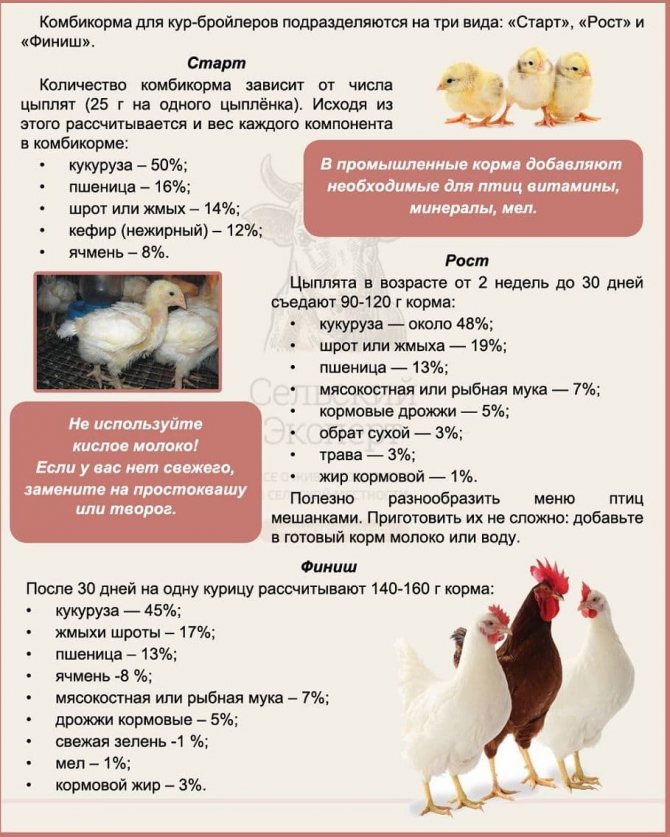

In the first period of fattening, the rate of food supply at a time is 50-90 grams per individual. Every 5-6 days, this amount should be increased by 1.5-2 times.
Compound feed for young animals
Start and finish are displayed in the animal ration. In a pork, chicken or turkey breed, growth directly depends on the nutrition and conditions of detention. the composition of adult poultry products is diluted with a variety of meat or vegetable additives. After the starting period, changes occur in layers and growth slowly stops, which is not necessary to be afraid, this is the norm. Roosters continue to grow. Commercially available feed (pk) is not always the best alternative to homemade mixes. Different price and quality influences the growth of birds.
The composition of PC or home-made feed during the start or finish period is clearly dosed. It is very difficult to study the composition of purchased products (2p or other types).But the proven composition of the mixture, which the farmer interferes with himself, is beyond doubt. For teaching beginners, photo instructions are suitable, which can be found on forums or useful Internet resources. It is necessary to separate the nutrition of adult chickens, roosters and young animals even in small farms. Diagrams and tables drawn up before the brood emerges will help maintain order and regulate a balanced diet.
Milk in the diet: what are the features of the choice of the product
It is not for nothing that dry breakfasts are poured with milk: it additionally receives nutritious animal protein and calcium. Just what is needed for full development. Milk should not be of the first freshness, but not peroxidized. Sour milk, which is not yet fully curdled, as well as acidified milk, can cause indigestion in chickens. In addition to milk, valuable substances can be obtained from:
- buttermilk;
- skimmed milk (skim milk);
- serum;
- fresh cottage cheese;
- curdled milk.
They are fed separately or together with grain mixtures. Curdled milk can be added from the first days of life of winged pets. But it should not replace water - constant watering of chickens with fresh clean water is mandatory.
Mixtures with the addition of dairy products deteriorate quickly, so they are scattered into the feeders immediately after production.
What products contribute to the successful rearing of chickens: photo
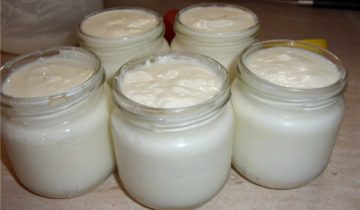

Sour milk for feeding broilers


A mixture of curd and grain for poultry
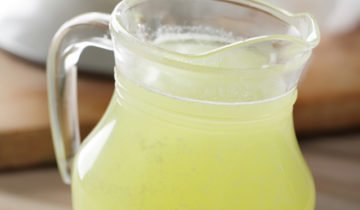

Serum to be added to feed

